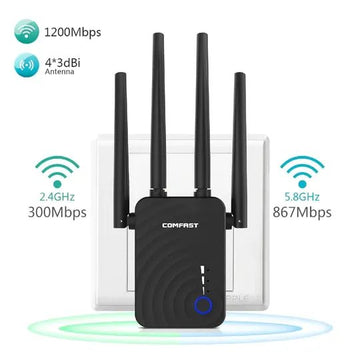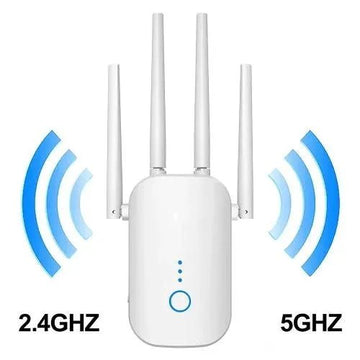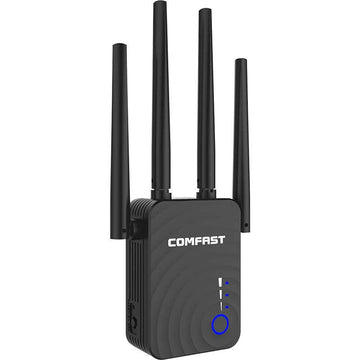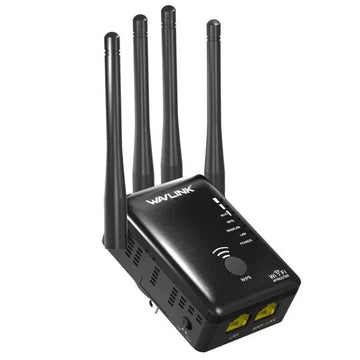Maximising Wifi Performance: How a Wifi Booster Can Help
In today's fast-paced digital world, reliable Wifi connectivity has become an indispensable requirement for both homes and offices. However, achieving seamless connectivity in large spaces presents unique challenges due to signal range limitations and obstacles that impede signal strength. To address these issues, Wifi boosters have emerged as a viable solution. In this article, we will explore the importance of reliable Wifi connectivity in large spaces, the challenges faced in achieving it, and delve into the world of Wifi boosters as an effective means to overcome these hurdles.
Importance of Reliable Wifi Connectivity in Large Spaces
In large spaces such as homes, offices, schools, or warehouses, having a robust Wifi network is crucial. It enables uninterrupted internet access, seamless communication, and efficient productivity. Whether it's streaming high-definition videos, conducting video conferences, or connecting multiple devices simultaneously, a stable Wifi connection is the backbone of modern connectivity. Without reliable Wifi, productivity suffers, and frustrations mount.
However, providing consistent Wifi coverage in large spaces comes with its own set of challenges. The primary obstacles include signal degradation due to distance, physical barriers like walls and floors, interference from other devices, and signal attenuation caused by obstacles such as furniture or machinery. These challenges can lead to dead zones—areas with little to no Wifi coverage and weak signal areas where the connection is unstable or sluggish. Consequently, these issues hinder the user experience and compromise productivity.
To overcome the challenges of achieving seamless Wifi connectivity in large spaces, Wifi boosters come to the rescue. Wifi boosters, also known as range extenders, repeaters, or mesh systems, amplify and distribute the Wifi signal to reach areas with limited coverage. They act as intermediaries between the router and devices, enhancing signal strength and extending coverage.
Understanding Wifi Boosters
A. Explanation of Wifi Boosters and Their Function
Wifi boosters are devices designed to amplify and extend the range of an existing Wifi network. They work by capturing the Wifi signal from the router and rebroadcasting it, effectively expanding the coverage area. By placing the Wifi booster strategically, the signal strength can be significantly increased, reducing dead zones and improving connectivity.
B. Types of Wifi Boosters Available
There are various types of Wifi boosters available in the market, including Wifi extenders, repeaters, and mesh systems.
Wifi Extenders: Extenders receive the existing Wifi signal and rebroadcast it, effectively extending the range. They are ideal for smaller spaces with a clear line of sight to the main router.
Wifi Repeaters: Repeaters receive and amplify the Wifi signal before transmitting it. They are suitable for spaces with obstacles that cause signal degradation.
Mesh Systems: Mesh systems consist of multiple nodes that work together to create a seamless Wifi network. They provide better coverage by eliminating dead zones and allowing devices to connect to the nearest node.
C. How Wifi Boosters Work to Improve Signal Strength and Coverage
Wifi boosters improve signal strength and coverage by acting as signal amplifiers or redistributors. They capture the existing Wifi signal, strengthen it, and transmit it to areas that were previously out of range. This amplification process ensures a stronger signal reaches devices, eliminating dead zones and enhancing the overall Wifi experience.
Assessing the Wifi Needs of Large Spaces
Before selecting a Wifi booster, it is crucial to evaluate the size and layout of the space in order to determine the optimal coverage requirements. Understanding the dimensions of the area and identifying potential obstacles, such as walls, furniture, or other physical barriers, helps in determining the number and placement of Wifi boosters needed for comprehensive coverage.
Conducting a thorough Wifi survey plays a vital role in assessing the signal strength and identifying areas with dead zones or weak signal coverage. There are various tools and mobile apps available that can measure the signal strength throughout the space, allowing for the identification of problem areas. By conducting this survey, it becomes possible to strategically plan the placement of Wifi boosters to eliminate dead zones and ensure a consistent signal throughout the entire space.
In addition to the physical aspects, considering the specific requirements of the space is essential. Factors such as the number of devices that need to be connected, the types of tasks performed (such as streaming, gaming, or office work), and the desired level of performance should be analysed. This analysis helps in selecting the most suitable Wifi booster that can meet the connectivity needs of the space. By understanding these requirements, it becomes possible to choose a Wifi booster that can handle the expected traffic and provide the desired level of performance.
By evaluating the size and layout of the space, conducting a Wifi survey to identify dead zones, and analysing the specific requirements of the area, one can make an informed decision when selecting a Wifi booster. This ensures optimal coverage, eliminates connectivity issues, and creates a seamless Wifi experience in large spaces.
Choosing the Right Wifi Booster
A. Factors to Consider When Selecting a Wifi Booster
When choosing a Wifi booster, several factors should be considered to ensure the best fit for your needs:
- Compatibility with Existing Wifi Network: It is crucial to ensure that the Wifi booster is compatible with the frequency and standards of your existing network. Check if it supports the same frequency band (e.g., 2.4GHz or 5GHz) and the same Wifi standards (e.g., 802.11ac or 802.11ax).
- Coverage Range and Signal Strength: Evaluate the booster's coverage range and signal strength. Consider the size of the space you want to cover and choose a booster with sufficient range to eliminate dead zones and provide strong, reliable signals throughout the area.
- Ease of Installation and Configuration: Look for a Wifi booster that offers straightforward installation and user-friendly configuration options. Consider whether it requires complex setup processes or if it has a user-friendly interface that simplifies the installation and configuration steps.
- Scalability for Future Expansion: If you have plans for future expansion or anticipate the addition of more devices to your network, choose a Wifi booster that supports scalability. Ensure it can handle increased demands and accommodate additional devices without compromising performance.
B. Comparing Different Wifi Booster Options Available in the Market
To make an informed decision, it is essential to research and compare various Wifi booster options available in the market. Consider factors such as features, performance, reliability, customer reviews, and the reputation of the manufacturer. Look for boosters that align closely with your specific requirements and have positive feedback from users in similar situations.
C. Reading Reviews and Customer Feedback
Reading reviews and customer feedback can provide valuable insights into the real-world performance and user experience of Wifi boosters. Pay attention to reviews from users who have similar space sizes or connectivity needs, as their feedback can help gauge how effective the booster is in large spaces. Consider both positive and negative reviews to have a comprehensive understanding before making a decision.
By considering these factors, comparing options, and reading customer feedback, you can select a Wifi booster that suits your needs, ensures seamless connectivity, and enhances your Wifi experience in large spaces.
Installation and Setup of Wifi Boosters
Before installing Wifi boosters, create a detailed plan that includes optimal booster placement and positioning. Consider the distance from the router, potential obstacles, and the coverage area each booster can provide. This planning will ensure a strategic installation for maximum signal strength and coverage.
Place the Wifi boosters strategically to maximise their effectiveness. Consider placing them in central locations, away from obstructions, and closer to areas with weak signal coverage. Adjust the booster's position based on signal strength measurements during the installation process.
Follow the manufacturer's instructions to configure the Wifi booster. Typically, this involves connecting the booster to the existing Wifi network and adjusting settings such as network name (SSID) and password. Pay attention to any advanced settings that can further optimise performance.
Managing and Optimising Wifi Boosters
To ensure Wifi boosters consistently deliver optimal performance, regular maintenance is key. One important aspect of maintenance is keeping the booster's firmware up to date. Manufacturers often release updates that include bug fixes, security enhancements, and performance improvements. By regularly checking for and installing these updates, users can ensure their Wifi boosters operate at their best.
In the event of connectivity issues, it's essential to be familiar with common troubleshooting steps for Wifi boosters. This can involve power cycling the booster, adjusting it's positioning to avoid interference, or reconfiguring settings to optimise performance. Troubleshooting guides provided by the manufacturer can be valuable resources in resolving these issues efficiently.
For advanced users seeking to maximise their Wifi booster's performance, several techniques can be employed. These may include adjusting channel settings to minimise congestion and interference, reducing the impact of other devices operating on the same frequency. Additionally, using multiple Wifi boosters to create a mesh network can further enhance coverage and signal strength. Implementing these advanced techniques effectively may require consulting specialised guides or seeking professional assistance.
Conclusion
Wifi boosters play a vital role in ensuring reliable connectivity in large spaces. By overcoming the challenges of signal range limitations and physical barriers, Wifi boosters enhance the Wifi experience for both homes and offices. Assessing the specific needs, selecting the right Wifi booster, strategically installing and configuring it, and regularly managing and optimising its performance are key steps to achieving seamless connectivity.
Investing in Wifi boosters is an investment in productivity, efficiency, and a smoother digital experience. Whether in homes or offices, embracing Wifi boosters empowers individuals and organisations to unlock the full potential of their Wifi networks and enjoy uninterrupted connectivity.





